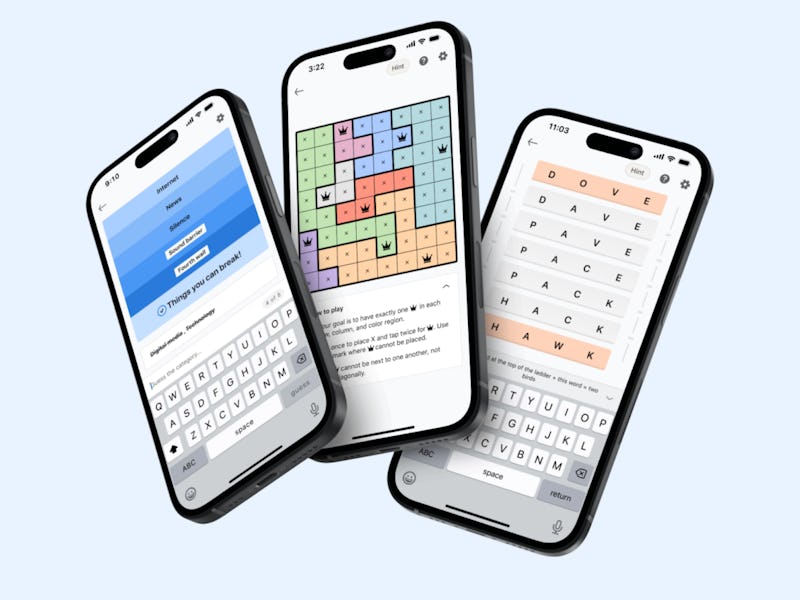You Can Play Puzzle Games On LinkedIn Now, But I Don’t Know Why You’d Want To
A puzzling addition.

I know what you’re thinking — you wish there was somewhere to go online where you could read the most inane social media drivel possible, find out which of your old college friends just became unemployed again, and play games all on the same site. We’ve all been there. And now, your wish has been granted, as the world’s greatest repository of brain-addled corporate executive spam has become a choice destination for word game fans. At least, its owners seem to be hoping so.
Following in the footsteps of The New York Times, LinkedIn has turned to word puzzles as a way of driving users to its site. If you head to LinkedIn’s games page, you’ll currently find three different games. Pinpoint reveals five words one by one and challenges players to identify the category they all belong to after revealing the fewest words. Queens is a Sudoku-esque game about correctly placing crowns on a grid with rules that restrict where they can be placed. Crossclimb asks players to guess five words from crossword-like clues, then rearrange them so that each word has just one letter different from the previous one, then guess two more words to finish off.
The massive success of Wordle has unsurprisingly spawned imitators.
It is, as you may have guessed from those descriptions, kind of a mish-mash of games you’ve likely played elsewhere. None of the options are bad per se, they’re just not that interesting. Of the three, Pinpoint is the most enjoyable, just because its premise makes it intuitive to play and simple to complete quickly. Those are two of the biggest factors that made Wordle such a hit that The New York Times dropped an undisclosed seven figures on it, so it’s not a bad model to follow.
All of LinkedIn’s new games would be adequate, if not particularly exciting, puzzles to help a long commute go by quicker. The problem isn’t the games themselves, but where they’re hosted. Even with X, née Twitter, in a state of perpetual implosion, the combination of self-promotion and “inspirational” posting from business-types angling at self-help influencer status makes LinkedIn easily the most mind-numbing social media site around. It’s not a place I spend any time on when I’m not desperate for work, anyway, as evidenced by the fact that LinkedIn apparently added these games in early May and I just heard about them.
Believe it or not, the internet used to be fun. Before social media sites became the only places people went online and Google controlled the flow of traffic seemingly by whim alone, there were blogs to read, forums to visit, and games basically everywhere. While the transformation of the web into a money-making tool may have rendered browsing much less enjoyable, some sites are returning to the old ways by bolting games onto their existing pages, but they may be the last place you’d ever want to go.
LinkedIn’s games are fine, but not worth visiting LinkedIn for.
For LinkedIn, the perks of adding games are clear. The New York Times says it’s getting tens of millions of players in Wordle alone each week, and along with other popular games like Connections, that led to a huge spike in app subscribers, as reported by Garbage Day. It makes sense that LinkedIn would want to get in on that, but less sense that its users would.
Part of the appeal of Wordle — probably the most important part — is that it’s a game designed to be shared with friends. Despite being a solitary game, its social media-ready scorecards after each round make it easy to start heated rivalries in your group chats and brag about the days when you one-shot the right answer while your friends struggle.
LinkedIn has a similar, but altogether more nauseating pitch for its own games.
“We hope that these games spark banter, conversations, and even a healthy bit of competition among professionals around the world,” LinkedIn vice president Daniel Roth wrote in a blog post announcing its games offerings earlier in May.
For reasons I can’t explain, LinkedIn things you want to talk to your boss about its new games.
Sharing your Wordle scores with friends is fun. Sharing your Pinpoint scores with your boss sounds decidedly less so. And of course, below the idea that LinkedIn wants to “spark banter,” is the reality that it really wants to drive engagement, that all-important goal of keeping users forever glued to your site that’s the be-all metric of success on the modern internet. After all, the longer you keep guessing at the connection between the words “jacket” and “leaf,” the longer LinkedIn has to try to convince you to sign up for its paid Premium tier (it took about eight seconds from opening the page for me to be served an ad via DM).
LinkedIn’s games aren’t going to be enough to keep me coming back to the site in the long term, as a way to cleanse your mind from the unrelenting absurdity of LinkedIn posts or pretend you’re networking while you’re slacking off, they’re not bad. But there are much better puzzle games to spend your time with (from the ultra-complex to the more low-key) without having to read about what your least-favorite coworker thinks is the key to happiness in incomprehensible business-speak.